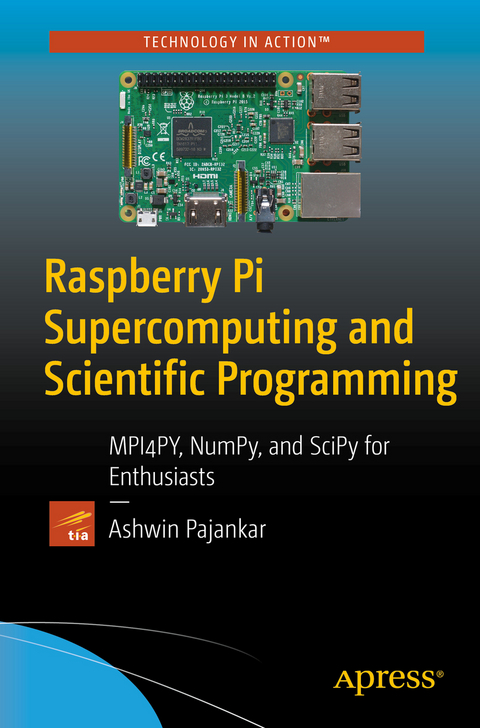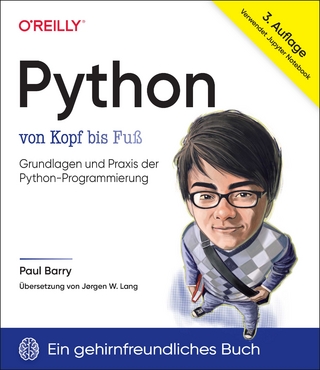
Raspberry Pi Supercomputing and Scientific Programming
Apress (Verlag)
978-1-4842-2877-7 (ISBN)
- Practical and hands-on approach to inexpensive supercomputing at home
- Tons of examples of parallel programming in Python 3
- Building a supercomputer with any version of the Raspberry Pi
Build an inexpensive cluster of multiple Raspberry Pi computers and install all the required libraries to write parallel and scientific programs in Python 3. This book covers setting up your Raspberry Pis, installing the necessary software, and making a cluster of multiple Pis.
Once the cluster is built, its power has to be exploited by means of programs to run on it. So, Raspberry Pi Supercomputing and Scientific Programming teaches you to code the cluster with the MPI4PY library of Python 3. Along the way, you will learn the concepts of the Message Passing Interface (MPI) standards and will explore the fundamentals of parallel programming on your inexpensive cluster. This will make this book a great starting point for supercomputing enthusiasts who want to get started with parallel programming.
The book finishes with details of symbolic mathematics and scientific and numerical programming in Python, using SymPi, SciPy, NumPy, and Matplotlib. You’ll see how to process signals and images, carry out calculations using linear algebra, and visualize your results, all using Python code. With the power of a Raspberry Pi supercomputer at your fingertips, data-intensive scientific programming becomes a reality at home.
You Will Learn
- Discover the essentials of supercomputing
- Build a low-cost cluster of Raspberry Pis at home
- Harness the power of parallel programming and the Message Passing Interface (MPI)
- Use your Raspberry Pi for symbolic, numerical, and scientific programming
This book is for Python 3 developers who seek the knowledge of parallel programming, Raspberry Pi enthusiasts, researchers, and the scientific Python community.
Ashwin Pajankar is a Polymath. He is a Science Popularizer, a Programmer, a Maker, an Author, and a Youtuber. He graduated from IIIT Hyderabad with MTech in Computer Science and Engineering. He has keen interest in the promotion of Science, Technology, Engineering, and Mathematics (STEM) education. This is his Second book with Apress Publication.
Chapter 1: Introduction to Raspberry PiSingle Board ComputersHistory of SBCsSoC (System on Chip)Major SBC familiesChapter 2: Important Linux Commands and Remote ConnectivityChapter 3: Introduction to PythonChapter 4: Introduction to SupercomputingChapter 5: Message Passing InterfaceChapter 6: Building a clusterTaking the backup of the MicroSD CardsPreparing the nodesNetworking the Pis TogetherTesting the clusterOrganizing the clusterChapter 7: Parallel Programming with MPICH and CMpicc compilerHello World ProgramMPI Processes: ranks and world sizeMore complex examplesChapter 8: Parallel Programming with MPI4PY and PythonGetting started with MPI4PYConditional statementsNumber of processes and world sizeSending and receiving the dataDynamic data exchangeData TaggingData BroadcastingData ScatteringData GatheringChapter 9: Conclusion and what's next
| Erscheinungsdatum | 29.06.2017 |
|---|---|
| Zusatzinfo | 90 Illustrations, color; 5 Illustrations, black and white |
| Verlagsort | Berkley |
| Sprache | englisch |
| Maße | 155 x 235 mm |
| Gewicht | 308 g |
| Einbandart | kartoniert |
| Themenwelt | Informatik ► Programmiersprachen / -werkzeuge ► Python |
| Mathematik / Informatik ► Informatik ► Software Entwicklung | |
| Informatik ► Theorie / Studium ► Compilerbau | |
| Informatik ► Weitere Themen ► Hardware | |
| Schlagworte | MicroSC Card • MPI4PY • MPICH • Raspberry Pi • Raspbian • Supercomputers |
| ISBN-10 | 1-4842-2877-4 / 1484228774 |
| ISBN-13 | 978-1-4842-2877-7 / 9781484228777 |
| Zustand | Neuware |
| Haben Sie eine Frage zum Produkt? |
aus dem Bereich


